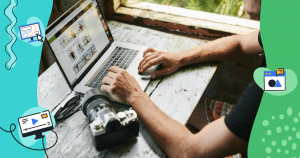Selling.
That’s the word that guides any company’s strategy, regardless of its size or the solutions offered.
Although the goal seems simple, achieving it can be a bit complex, given the diversity of factors that can influence the process.
Today, sales results depend directly on the company’s ability to understand the motivations, pains, and needs of its audience.
From this, it’s possible to produce content and actions with the power not only to attract the buyer persona but also to direct your leads to the buying decision.
For a business to achieve it, it’s necessary to adopt a strategic approach, mapping the entire path taken by the customers since their first contact with the brand.
That enables the creation of qualified experiences, which can result in the construction of long-term and profitable relationships.
Behind all this approach, there’s the buyer’s journey, a concept we’ll address throughout this text.
Here you’ll find out:
- What is the buyer’s journey?
- Why do you need to trace a buyer’s journey for your business?
- How to define a buyer’s journey for your company?
- What are the best types of content for each stage?
Keep on reading!
Download this post by entering your email below
What is the buyer’s journey?
The buyer’s journey is a concept that seeks to map the path taken by a person until they decide to buy a solution from your company. It begins with the prospect’s first contact with the brand, which can come from friends’ referrals, online content, or other marketing efforts.
The idea is based on the principle that, before acknowledging the solution offered, the consumers do not know they need it.
However, as they go through the different stages of the journey, they gain awareness about their own needs.
Then, they begin to consider the acquisition of a product or service.
With this knowledge acquired, the consumer considers the different options they may use to solve their problem.
After analyzing the alternatives, they finally come to a decision and execute the purchase.
During the process we have just described, there are three fundamental stages, which we will explore further throughout the text. They are:
- awareness;
- consideration;
- decision.

Here, it’s interesting to note that if you know how to communicate efficiently with your customers during each of these phases, your company can achieve several advantages, which go beyond boosting sales.
In the next topic, we will talk more about it.
Why do you need to trace a buyer’s journey for your business?
As you probably already know, establishing excellent communication with your audience is vital to your business performance.
That’s has always been true, but it has become even more critical at the age of 4.0 Marketing.
The dominant audience at the moment, called the 4.0 consumer, gives great importance to the experiences provided by brands during their buying journeys.
To be good enough, you need to know at what stage each lead is.
By mapping this journey, you have the power to offer more and more personalized experiences, optimizing the impact on the consumer and enabling an increasingly closer relationship.
Also, working with a focus on the buyer’s journey enables continuous learning about the pains, problems, motivations, and needs of your target audience.
These results create more effective marketing campaigns and deliver more appropriate solutions.
On the other hand, neglecting the journey can damage your relationship with the customer.
In any kind of contact between the company and the leads, it’s essential to know at what stage the prospect is to perform an adequate approach.
Imagine, for example, that a client is in the first phase of the funnel and gets in touch with one of your salespeople.
This phase, called awareness, is characterized by people who are not ready to make a purchase.
If, without knowing about it, your sales rep tries to force a sale, it can scare the lead away and waste an opportunity that is difficult to reclaim.
To understand this better, you need to know more about the different phases of the journey. So, read the next topic!

How to define a buyer’s journey for your company?
The first step in defining the buyer’s journey for your company could be nothing else: deeply understanding your consumer.
For you to accomplish this, the most recommended practice is to build a buyer persona. Don’t know what it is? We explain!
The buyer persona is a semi-fictive profile that aims to simulate the characteristics of your ideal consumer.
It’s a character, which must be deeply detailed and unique so you can direct your marketing and communication efforts to it.
At certain points, it resembles the target audience, but it goes much further. Besides demographic data such as gender, age, and location, the persona should include details that humanize the profile, such as motivations, needs, pains, hobbies, and goals.
Once you have your persona defined, you can go deeper into the three stages of your consumer journey.
Next, we’ll talk about each one of them and what you need to consider to promote a compelling experience to your buyers.
Awareness
In the first stage of the journey, it’s normal that the consumer doesn’t even know they have a problem that it’s difficult to solve.
It’s possible, however, that they feel that something is off and start looking for more information on the subject.
If you have a good SEO strategy, your blog can be found at this stage.
From that point on, the company’s goal must be to educate the persona, showing the problem they must face and acting as a true consultant. Therefore, it’s not the time to talk about the brand or the solutions.
The idea is to help the consumer identify their pain. That way, they’ll start consuming your content in search of a solution. When they achieve this point, they move on to the next step.
Consideration
The stage of consideration is marked by a change in the consumer’s attitude. In it, the persona already knows the problem they want to solve but is not yet sure which is the best solution for the specific case.
The ideal is that your company continues to operate consultatively, consolidating itself as a reliable source of information for the lead.
Products and services can even be mentioned but subtly and delicately. You should clarify that more than selling, you want to help the persona.
The content offered at this stage may already be a little more specific, as we’ll see later.
The idea is that the persona realizes, alone, that it may be necessary to make some sort of investment to acquire the most effective solution. Thus, all that remains is to decide which company to buy from.
Decision
When the persona decides they need to acquire a solution for the problem, they enter the decision phase of the buyer’s journey.
If your nurturing efforts have been well-done, they’ll consider your brand as one of the most relevant alternatives.
This is the moment your sales reps were waiting for. They can start acting to finally convince the lead that buying your product or service is the best option.
What are the best types of content for each stage?
The whole point of defining a buyer’s journey is that you have more control over the persona’s decision making.
With the right approach, you can influence the consumer to the purchasing decision.
For this, it’s essential to have a solid Content Marketing strategy that considers not only the characteristics of the persona but also the phase of the journey in which they are.
Let’s talk a little about the best types of content for each stage.
Awareness
When producing content aimed at the awareness phase, keep in mind that the buyer persona still knows little about the problem they face.
Therefore, use simple language, and seek a broader approach, avoiding getting into more complex issues.
This way, blog posts are excellent materials for the first phase of the journey.
They can give the consumer the knowledge needed to identify the problem and start looking for reliable solutions.
Another type of content that fits this stage is video. Whether on YouTube or social networks, videos are excellent resources to attract the persona’s attention and answer the most basic questions.
Consideration
The consideration stage allows the creation of more complex content, which speaks more specifically about the solutions that the consumer can acquire to achieve their goal.
Besides blog posts, you can use ebooks to provide more in-depth information. What many companies do is offer these materials on a landing page to acquire the consumer’s contact information, turning them into leads.
Podcasts and infographics are other examples of content that can help the consumer move on to the next phase of the journey.
Decision
As the name already implies, this step is decisive. After evaluating different options, it’s at this stage that the consumer will choose the one they consider most appropriate for their situation.
Therefore, it’s time to make clear the benefits presented by your company. For this, you can make use of interactive calculators, tools that highlight what the investment in your solution can represent for the persona.
It’s also valid to make testimonials left by other customers to underpin your product/service and stimulate the purchase decision.
Understanding the buyer’s journey is essential for your company to approach the buyer persona in the best way, offering personalized and attractive content.
It’s important to take into account the particularities of each stage, to know if the lead is ready to make the purchase.
Want to keep learning? In this text, we list the 14 digital metrics to measure your strategy in 2020. Check it out!









